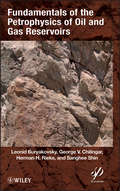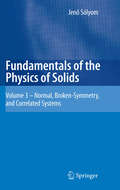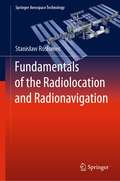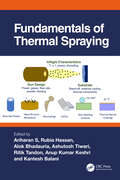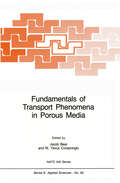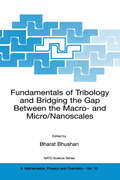- Table View
- List View
Fundamentals of the Optics of Materials: Tutorial and Problem Solving
by Vladimir I. Gavrilenko Volodymyr S. OvechkoThis textbook showcases the rapidly developing field of materials optics. It is aimed at a broad audience as the readers require only university entry level knowledge of physics, chemistry, and optics. It overviews the basics of optical engineering and the typical and widely used applications of materials optics, with the first general chapters corresponding to the standard university courses, targeting bachelor’s and master’s degrees in physics. The next few chapters present the modern developments in materials optics, such as nano-plasmonics, nano-photonics, and optical properties of nano-sized materials, intended for readers familiar with the basic elements of quantum mechanics. Some more specialized chapters address recent developments in fields such as optics of solid surfaces, plasma optics, optics of composites, alloys, and metamaterials; optics of anisotropic materials; optics of organic and biological materials; and relativistic effects in optics. The appendices present a more advanced description of selected topics, with important reference materials, subject index, and extended list of publications, as well as numerous examples and problems to better orient readers interested in gaining further knowledge of the subject.
Fundamentals of the Optics of Materials: Tutorial and Problem Solving
by Vladimir I. Gavrilenko Volodymyr S. OvechkoThis textbook showcases the rapidly developing field of materials optics. It is aimed at a broad audience as the readers require only university entry level knowledge of physics, chemistry, and optics. It overviews the basics of optical engineering and the typical and widely used applications of materials optics, with the first general chapters corresponding to the standard university courses, targeting bachelor’s and master’s degrees in physics. The next few chapters present the modern developments in materials optics, such as nano-plasmonics, nano-photonics, and optical properties of nano-sized materials, intended for readers familiar with the basic elements of quantum mechanics. Some more specialized chapters address recent developments in fields such as optics of solid surfaces, plasma optics, optics of composites, alloys, and metamaterials; optics of anisotropic materials; optics of organic and biological materials; and relativistic effects in optics. The appendices present a more advanced description of selected topics, with important reference materials, subject index, and extended list of publications, as well as numerous examples and problems to better orient readers interested in gaining further knowledge of the subject.
Fundamentals of the Petrophysics of Oil and Gas Reservoirs
by Leonid Buryakovsky G. V. Chilingar Herman H. Rieke Sanghee ShinWritten by some of the world’s most renowned petroleum and environmental engineers, Petrophysics: The Fundamentals of Oil and Gas Revervoirs is the first book to offer the practicing engineer and engineering student these new cutting-edge techniques for prediction and forecasting in petroleum engineering and environmental management.
Fundamentals of the Petrophysics of Oil and Gas Reservoirs
by Leonid Buryakovsky G. V. Chilingar Herman H. Rieke Sanghee ShinWritten by some of the world’s most renowned petroleum and environmental engineers, Petrophysics: The Fundamentals of Oil and Gas Revervoirs is the first book to offer the practicing engineer and engineering student these new cutting-edge techniques for prediction and forecasting in petroleum engineering and environmental management.
Fundamentals of the Physical-Chemistry of Pulverized Coal Combustion (NATO Science Series E: #137)
by L. Lahaye G. PradoThe study of coal for the production of energy is certainly not a new area of research. Many research works were carried out to improve the efficiency of industrial and domestic facilities. In the sixties, however, because of the availability and low cost of petroleum, coal consumption decreased and the research effort in this area was minimum. Meanwhile, the situation has totally changed. Considering the reserves of oil and the instability ofregions where they are located, it is becoming absolutely necessary to develop other sources of energy.The major alternative to oil appears to be coal, at least for the near future. Indeed, the reserves known today represent several centuries of energy consumption.!t is therefore becoming urgent to develop efficient and non polluting technologies to produce energy from coal. The main possibilities are : · liquefaction · gasification · directed combustion. Research and development efforts on liquefaction have been considerably reduced because of high cost of technologies involved and poor prospects for the next two decades. Research works on gasification are progressing; it is a promising approach. However, direct combustion either in pulverized coal furnaces or in fluidized beds is the more promising way of expanding rapidly the utilization of coal. These techniques are already used in some facilities but many environmental problems remain, slowing down their development.
Fundamentals of the Physics of Solids: Volume 3 - Normal, Broken-Symmetry, and Correlated Systems
by Jenö SólyomThis book is the third of a three-volume series written by the same author. It aims to deliver a comprehensive and self-contained account of the fundamentals of the physics of solids. In the presentation of the properties and experimentally observed phenomena together with the basic concepts and theoretical methods, it goes far beyond most classic texts. The essential features of various experimental techniques are also explained. This volume is devoted mostly to the discussion of the effects of electron—electron interaction beyond the one-electron approximation. The density-functional theory is introduced to account for correlation effects. The response to external perturbations is discussed in the framework of linear response theory. Landau’s Fermi-liquid theory is followed by the theory of Luttinger liquids. The subsequent chapters are devoted to electronic phases with broken symmetry: to itinerant magnetism, to spin- and charge-density waves and their realizations in quasi-one-dimensional materials, as well as to the microscopic theory of superconductivity. An overview is given of the physics of strongly correlated systems. The last chapter covers selected problems in the physics of disordered systems.
Fundamentals of the Radiolocation and Radionavigation (Springer Aerospace Technology)
by Stanisław RosłoniecThe book presents principles of operation of radar and radionavigation systems. The group of radar systems includes: primary and secondary radiolocations, bistatic and multistatic systems. They are illustrated with relevant examples of calculation and applications. The issues of increasing the range of the radar systems are presented together with the matched filtering of the used signals. Other discussed issues are methods for eliminating interfering signals and researching methods of 3D space. Various methods of the monopulse radiolocation are presented in Chapter 12. In Chapters 13–18 terrestrial and satellite radionavigation systems are under discussion. The terrestrial systems are: Loran C, Decca Navigator and Omega. The TRANSIT is an example of a hyperbolic satellite system. The stadiometric systems GPS, GLONASS, GALILEO, BeiDou, IRNSS and QZSS are discussed together with differential systems augmentating of them. The ILS, MLS and TLS supporting the landing of aircrafts are discussed in Chapter 17. The prospects for replacing of them with satellite systems augmentated by appropriate reference ground-based stations (GBAS) are also analyzed. Various beacons and ranging devices used in aviation are described in the Chapter 18. This book is intended primarily for students and engineers interested in radar, radionavigation and aerospace engineering.
Fundamentals of the Three-Dimensional Theory of Stability of Deformable Bodies (Foundations of Engineering Mechanics)
by A.N. GuzAt the present time stability theory of deformable systems has been developed into a manifold field within solid mechanics with methods, techniques and approaches of its own. We can hardly name a branch of industry or civil engineering where the results of the stability theory have not found their application. This extensive development together with engineering applications are reflected in a flurry of papers appearing in periodicals as well as in a plenty of monographs, textbooks and reference books. In so doing, overwhelming majority of researchers, con cerned with the problems of practical interest, have dealt with the loss of stability in the thin-walled structural elements. Trying to simplify solution of the problems, they have used two- and one-dimensional theories based on various auxiliary hypotheses. This activity contributed a lot to the preferential development of the stability theory of thin-walled structures and organisation of this theory into a branch of solid mechanics with its own up-to-date methods and trends, but left three-dimensional linearised theory of deformable bodies stability (TL TDBS), methods of solving and solutions of the three-dimensional stability problems themselves almost without attention. It must be emphasised that by three dimensional theories and problems in this book are meant those theories and problems which do not draw two-dimensional plate and shell and one-dimensional rod theories.
Fundamentals of Thermal Radiation for Energy Utilization in Fuel Combustion (Advanced Topics in Science and Technology in China #67)
by Shiquan Shan Zhijun Zhou Yanwei ZhangThis book is in the field of Engineering Thermophysics. It first introduces the authors’ academic thoughts of photo-thermal energy cascade conversion in the fuel combustion. Afterward, a series of thermal radiation theories and models have been developed based on the aim of radiative energy utilization, including spectral radiation available energy theory, gas radiation model under complex combustion conditions, and calculation model of radiation available energy transfer in combustion medium. Based on simulation and experimental results, the radiative energy characteristics of different fuel combustion are introduced. This book develops the radiation theory of the combustion process from a new perspective, integrating theories, models, and experimental results. This book can be used as a reference for scientists, engineers, and graduate students engaged in energy environment, combustion, and thermal radiation.
Fundamentals of Thermal Spraying
by Alok Bhadauria Ashutosh Tiwari Ritik Tandon Anup Kumar Keshri Kantesh Balani Ariharan S Rubia HassanThis book discusses the concepts and uses of thermal spraying including starting powder, spraying parameters, diagnostics, coating deposition, evolved microstructure and resulting properties complemented with several case studies to associate the learnings with applied concepts. The major parts of the instrumentation, the spraying gun, which is the fundamental aspect of different thermal spraying conditions are also discussed. Solved examples, numerical problems and descriptive questions are included for self-assessment at the end of every chapter. The book: Discusses all aspects from starting powder, spraying parameters, diagnostics and coating deposition; Explores schematics to highlight the conceptual notes; Includes multiple case studies from domains including aerospace, biomedical, manufacturing, wettability and others to highlight the practical application of thermally sprayed coatings; Covers classification of thermal spray techniques; and Contains solved example, numerical problems and descriptive questions for self-assessment. This book is aimed at senior undergraduates and graduates in materials science and engineering.
Fundamentals of Thermal Spraying
by Ariharan S Rubia Hassan Alok Bhadauria Ashutosh Tiwari Ritik Tandon Anup Kumar Keshri Kantesh BalaniThis book discusses the concepts and uses of thermal spraying including starting powder, spraying parameters, diagnostics, coating deposition, evolved microstructure and resulting properties complemented with several case studies to associate the learnings with applied concepts. The major parts of the instrumentation, the spraying gun, which is the fundamental aspect of different thermal spraying conditions are also discussed. Solved examples, numerical problems and descriptive questions are included for self-assessment at the end of every chapter. The book: Discusses all aspects from starting powder, spraying parameters, diagnostics and coating deposition; Explores schematics to highlight the conceptual notes; Includes multiple case studies from domains including aerospace, biomedical, manufacturing, wettability and others to highlight the practical application of thermally sprayed coatings; Covers classification of thermal spray techniques; and Contains solved example, numerical problems and descriptive questions for self-assessment. This book is aimed at senior undergraduates and graduates in materials science and engineering.
Fundamentals of Thermodynamics
by John H. Lee K. RamamurthiA concise treatment of the fundamentals of thermodynamics is presented in this book. In particular, emphasis is placed on discussions of the second law, a unique feature of thermodynamics, which states the limitations of converting thermal energy into mechanical energy. The entropy function that permits the loss in the potential of a real thermodynamic process to be assessed, the maximum possible work in a process, and irreversibility and equilibrium are deduced from the law through physical and intuitive considerations. They are applicable in mitigating waste heat and are useful for solving energy, power, propulsion and climate-related issues.The treatment is not restricted to properties and functions of ideal gases. The ideal gas assumption is invoked as a limiting case. Reversible paths between equilibrium states are obtained using reversible heat engines and reversible heat pumps between environment and systems to determine the entropy changes and the maximum work. The conditions of thermodynamic equilibrium comprising mechanical, thermal, chemical and phase equilibrium are addressed and the species formed at equilibrium in a chemical reaction at a given temperature and pressure are obtained. The molecular basis for the laws of thermodynamics, temperature, internal energy changes, entropy, reversibility and equilibrium are briefly discussed.The book serves as a reference for undergraduate and graduate students alongside thermodynamics textbooks.
Fundamentals of Thermodynamics
by John H. Lee K. RamamurthiA concise treatment of the fundamentals of thermodynamics is presented in this book. In particular, emphasis is placed on discussions of the second law, a unique feature of thermodynamics, which states the limitations of converting thermal energy into mechanical energy. The entropy function that permits the loss in the potential of a real thermodynamic process to be assessed, the maximum possible work in a process, and irreversibility and equilibrium are deduced from the law through physical and intuitive considerations. They are applicable in mitigating waste heat and are useful for solving energy, power, propulsion and climate-related issues.The treatment is not restricted to properties and functions of ideal gases. The ideal gas assumption is invoked as a limiting case. Reversible paths between equilibrium states are obtained using reversible heat engines and reversible heat pumps between environment and systems to determine the entropy changes and the maximum work. The conditions of thermodynamic equilibrium comprising mechanical, thermal, chemical and phase equilibrium are addressed and the species formed at equilibrium in a chemical reaction at a given temperature and pressure are obtained. The molecular basis for the laws of thermodynamics, temperature, internal energy changes, entropy, reversibility and equilibrium are briefly discussed.The book serves as a reference for undergraduate and graduate students alongside thermodynamics textbooks.
Fundamentals of Tissue Engineering and Regenerative Medicine
by Jörg Handschel Hans Peter Wiesmann Ulrich Meyer Thomas Meyer"Fundamentals of Tissue Engineering and Regenerative Medicine" provides a complete overview of the state of the art in tissue engineering and regenerative medicine. Tissue engineering has grown tremendously during the past decade. Advances in genetic medicine and stem cell technology have significantly improved the potential to influence cell and tissue performance, and have recently expanded the field towards regenerative medicine. In recent years a number of approaches have been used routinely in daily clinical practice, others have been introduced in clinical studies, and multitudes are in the preclinical testing phase. Because of these developments, there is a need to provide comprehensive and detailed information for researchers and clinicians on this rapidly expanding field. This book offers, in a single volume, the prerequisites of a comprehensive understanding of tissue engineering and regenerative medicine. The book is conceptualized according to a didactic approach (general aspects: social, economic, and ethical considerations; basic biological aspects of regenerative medicine: stem cell medicine, biomolecules, genetic engineering; classic methods of tissue engineering: cell, tissue, organ culture; biotechnological issues: scaffolds; bioreactors, laboratory work; and an extended medical discipline oriented approach: review of clinical use in the various medical specialties). The content of the book, written in 68 chapters by the world’s leading research and clinical specialists in their discipline, represents therefore the recent intellect, experience, and state of this bio-medical field.
Fundamentals of Tractor Design
by Karl Theodor ReniusThis textbook offers a comprehensive review of tractor design fundamentals. Discussing more than hundred problems and including about six hundred international references, it offers a unique resource to advanced undergraduate and graduate students, researchers and also practical engineers, managers, test engineers, consultants and even old-timer fans. Tractors are the most important pieces of agricultural mechanization, hence a key factor of feeding the world. In order to address the educational needs of both less and more developed countries, the author included fundamentals of simple but proved designs for tractors with moderate technical levels, along with extensive information concerning modern, premium tractors. The broad technical content has been structured according to five technology levels, addressing all components. Relevant ISO standards are considered in all chapters. The book covers historical highlights, tractor project management (including cost management), traction mechanics, tires (including inflation control), belt ground drives, and ride dynamics. Further topics are: chassis design, diesel engines (with emission limits and installation instructions), all important types of transmissions, topics in machine element design, and human factors (health, safety, comfort). Moreover, the content covers tractor-implement management systems, in particular ISOBUS automation and hydraulic systems. Cumulative damage fundamentals and tractor load spectra are described and implemented for dimensioning and design verification. Fundamentals of energy efficiency are discussed for single tractor components and solutions to reduce the tractor CO2 footprint are suggested.
Fundamentals of Traffic Simulation (International Series in Operations Research & Management Science #145)
by Jaume BarcelóThe increasing power of computer technologies, the evolution of software en- neering and the advent of the intelligent transport systems has prompted traf c simulation to become one of the most used approaches for traf c analysis in s- port of the design and evaluation of traf c systems. The ability of traf c simulation to emulate the time variability of traf c phenomena makes it a unique tool for capturing the complexity of traf c systems. In recent years, traf c simulation – and namely microscopic traf c simulation – has moved from the academic to the professional world. A wide variety of traf- c simulation software is currently available on the market and it is utilized by thousands of users, consultants, researchers and public agencies. Microscopic traf c simulation based on the emulation of traf c ows from the dynamics of individual vehicles is becoming one the most attractive approaches. However, traf c simulation still lacks a uni ed treatment. Dozens of papers on theory and applications are published in scienti c journals every year. A search of simulation-related papers and workshops through the proceedings of the last annual TRB meetings would support this assertion, as would a review of the minutes from speci cally dedicated meetings such as the International Symposiums on Traf c Simulation (Yokohama, 2002; Lausanne, 2006; Brisbane, 2008) or the International Workshops on Traf c Modeling and Simulation (Tucson, 2001; Barcelona, 2003; Sedona, 2005; Graz 2008). Yet, the only comprehensive treatment of the subject to be found so far is in the user’s manuals of various software products.
Fundamentals of Transport Phenomena in Porous Media (NATO Science Series E: #82)
by Jacob Bear M. Y. CorapciogluThis volume contains the lectures presented at the NATO Advanced Study Institute that took place at the University of Delaware, Newark, Delaware, July 18-27, 1982. The purpose of this Institute was to provide an international forum for exchange of ideas and dissemination of knowledge on some selected topics in Mechanics of Fluids in Porous Media. Processes of transport of such extensive quantities as mass of a phase, mass of a component of a phase, momentum and/or heat occur in diversified fields, such as petroleum reservoir engineer ing, groundwater hydraulics, soil mechanics, industrial filtration, water purification, wastewater treatment, soil drainage and irri gation, and geothermal energy production. In all these areas, scientists, engineers and planners make use of mathematical models that describe the relevant transport processes that occur within porous medium domains, and enable the forecasting of the future state of the latter in response to planned activities. The mathe matical models, in turn, are based on the understanding of phenomena, often within the void space, and on theories that re late these phenomena to measurable quantities. Because of the pressing needs in areas of practical interest, such as the develop ment of groundwater resources, the control and abatement of groundwater contamination, underground energy storage and geo thermal energy production, a vast amount of research efforts in all these fields has contributed, especially in the last t~o decades, to our understanding and ability to describe transport phenomena.
Fundamentals of Tribology and Bridging the Gap Between the Macro- and Micro/Nanoscales (NATO Science Series II: Mathematics, Physics and Chemistry #10)
by Bharat BhushanThe word tribology was fIrst reported in a landmark report by P. Jost in 1966 (Lubrication (Tribology)--A Report on the Present Position and Industry's Needs, Department of Education and Science, HMSO, London). Tribology is the science and technology of two interacting surfaces in relative motion and of related subjects and practices. The popular equivalent is friction, wear and lubrication. The economic impact of the better understanding of tribology of two interacting surfaces in relative motion is known to be immense. Losses resulting from ignorance of tribology amount in the United States alone to about 6 percent of its GNP or about $200 billion dollars per year (1966), and approximately one-third of the world's energy resources in present' use, appear as friction in one form or another. A fundamental understanding of the tribology of the head-medium interface in magnetic recording is crucial to the future growth of the $100 billion per year information storage industry. In the emerging microelectromechanical systems (MEMS) industry, tribology is also recognized as a limiting technology. The advent of new scanning probe microscopy (SPM) techniques (starting with the invention of the scanning tunneling microscope in 1981) to measure surface topography, adhesion, friction, wear, lubricant-fIlm thickness, mechanical properties all on a micro to nanometer scale, and to image lubricant molecules and the availability of supercomputers to conduct atomic-scale simulations has led to the development of a new fIeld referred to as Microtribology, Nanotribology, or Molecular Tribology (see B. Bhushan, J. N. Israelachvili and U.
Fundamentals of Tunnel Field-Effect Transistors
by Mamidala Jagadesh Kumar Sneh SaurabhDuring the last decade, there has been a great deal of interest in TFETs. To the best authors’ knowledge, no book on TFETs currently exists. The proposed book provides readers with fundamental understanding of the TFETs. It explains the interesting characteristics of the TFETs, pointing to their strengths and weaknesses, and describes the novel techniques that can be employed to overcome these weaknesses and improve their characteristics. Different tradeoffs that can be made in designing TFETs have also been highlighted. Further, the book provides simulation example files of TFETs that could be run using a commercial device simulator.
Fundamentals of Tunnel Field-Effect Transistors
by Sneh Saurabh Mamidala Jagadesh KumarDuring the last decade, there has been a great deal of interest in TFETs. To the best authors’ knowledge, no book on TFETs currently exists. The proposed book provides readers with fundamental understanding of the TFETs. It explains the interesting characteristics of the TFETs, pointing to their strengths and weaknesses, and describes the novel techniques that can be employed to overcome these weaknesses and improve their characteristics. Different tradeoffs that can be made in designing TFETs have also been highlighted. Further, the book provides simulation example files of TFETs that could be run using a commercial device simulator.
Fundamentals of Turbomachines (Fluid Mechanics and Its Applications #109)
by Erik DickThis book explores the working principles of all kinds of turbomachines. The same theoretical framework is used to analyse the different machine types. Fundamentals are first presented and theoretical concepts are then elaborated for particular machine types, starting with the simplest ones.For each machine type, the author strikes a balance between building basic understanding and exploring knowledge of practical aspects. Readers are invited through challenging exercises to consider how the theory applies to particular cases and how it can be generalised. The book is primarily meant as a course book. It teaches fundamentals and explores applications. It will appeal to senior undergraduate and graduate students in mechanical engineering and to professional engineers seeking to understand the operation of turbomachines. Readers will gain a fundamental understanding of turbomachines. They will also be able to make a reasoned choice of turbomachine for a particular application and to understand its operation. Basic design of the simplest turbomachines as a centrifugal fan, an axial steam turbine or a centrifugal pump, is also possible using the topics covered in the book.
Fundamentals of Turbomachines (Fluid Mechanics and Its Applications #130)
by Erik DickThis textbook explores the working principles of all kinds of turbomachines. The same theoretical framework is used to analyze the different machine types. The order in which the different kinds are treated is chosen by the possibility of gradually building up theoretical concepts. For each of the turbomachine kinds, a balance is sought between fundamental understanding and knowledge of practical aspects. Readers are invited through challenging exercises to consider how the theory applies to particular cases. This textbook appeals to senior undergraduate and graduate students in mechanical engineering and to professional engineers seeking to understand the operation of turbomachines. Readers will gain a fundamental understanding of turbomachines and will be able to make a reasoned choice of a turbomachine for a particular application.
Fundamentals of Two-Fluid Dynamics: Part II: Lubricated Transport, Drops and Miscible Liquids (Interdisciplinary Applied Mathematics #4)
by Daniel D. Joseph Yuriko Y. RenardyTwo-fluid dynamics is a challenging subject rich in physics and prac tical applications. Many of the most interesting problems are tied to the loss of stability which is realized in preferential positioning and shaping of the interface, so that interfacial stability is a major player in this drama. Typically, solutions of equations governing the dynamics of two fluids are not uniquely determined by the boundary data and different configurations of flow are compatible with the same data. This is one reason why stability studies are important; we need to know which of the possible solutions are stable to predict what might be observed. When we started our studies in the early 1980's, it was not at all evident that stability theory could actu ally work in the hostile environment of pervasive nonuniqueness. We were pleasantly surprised, even astounded, by the extent to which it does work. There are many simple solutions, called basic flows, which are never stable, but we may always compute growth rates and determine the wavelength and frequency of the unstable mode which grows the fastest. This proce dure appears to work well even in deeply nonlinear regimes where linear theory is not strictly valid, just as Lord Rayleigh showed long ago in his calculation of the size of drops resulting from capillary-induced pinch-off of an inviscid jet.
Fundamentals of Two-Fluid Dynamics: Part I: Mathematical Theory and Applications (Interdisciplinary Applied Mathematics #3)
by Daniel D. Joseph Yuriko Y. RenardyTwo-fluid dynamics is a challenging subject rich in physics and prac tical applications. Many of the most interesting problems are tied to the loss of stability which is realized in preferential positioning and shaping of the interface, so that interfacial stability is a major player in this drama. Typically, solutions of equations governing the dynamics of two fluids are not uniquely determined by the boundary data and different configurations of flow are compatible with the same data. This is one reason why stability studies are important; we need to know which of the possible solutions are stable to predict what might be observed. When we started our studies in the early 1980's, it was not at all evident that stability theory could actu ally work in the hostile environment of pervasive nonuniqueness. We were pleasantly surprised, even astounded, by the extent to which it does work. There are many simple solutions, called basic flows, which are never stable, but we may always compute growth rates and determine the wavelength and frequency of the unstable mode which grows the fastest. This proce dure appears to work well even in deeply nonlinear regimes where linear theory is not strictly valid, just as Lord Rayleigh showed long ago in his calculation of the size of drops resulting from capillary-induced pinch-off of an inviscid jet.
Fundamentals of Ultrasonic Nondestructive Evaluation: A Modeling Approach (Springer Series in Measurement Science and Technology)
by Lester W. Schmerr Jr.This extensively revised and updated second edition of a widely read classic presents the use of ultrasound in nondestructive evaluation (NDE) inspections. Retaining the first edition's use of wave propagation /scattering theory and linear system theory, this volume also adds significant new material including:the introduction of MATLAB® functions and scripts that evaluate key results involving beam propagation and scattering, flaw sizing, and the modeling of ultrasonic systems.elements of Gaussian beam theory and a multi-Gaussian ultrasonic beam model for bulk wave transducers.a new chapter on the connection between ultrasonic modeling and probability of detection (POD) and reliability models.new and improved derivations of ultrasonic measurement models.updated coverage of ultrasonic simulators that have been developed around the world.Students, engineers, and researchers working in the ultrasonic NDE field will find a wealth of information on the modeling of ultrasonic inspections and the fundamental ultrasonic experiments that support those models in this new edition.

